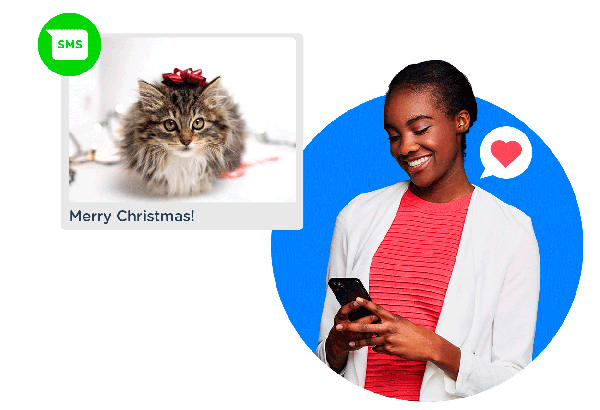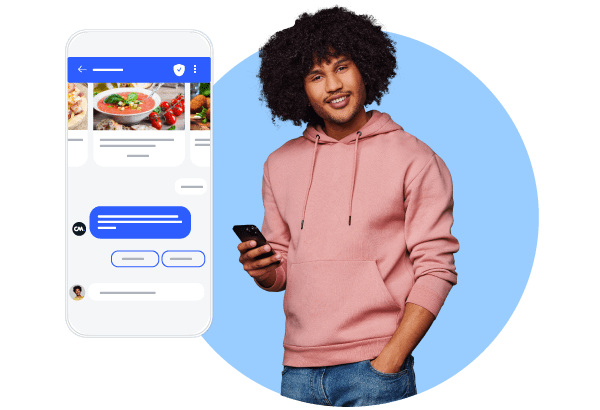- 30 Facts You May Not Know About SMS
- What Does the Future Hold for SMS?
- From SMS to RCS
- All Channels Via a Single API
30 Facts You May Not Know About SMS
The very first SMS was sent on December 3, 1992 by the British engineer Neil Papworth, from the company Vodafone.
"Merry Christmas" was the content of this very first SMS, sent from a computer to a cell phone weighing about 2 kilos.
The idea of creating a network for sending and receiving short messages between cell phones came to Matti Makkonen a few years earlier, in 1984, while he was eating pizza with his friends in Copenhagen (just goes to show that the best ideas can come from places where you least expect them!)
By the way, Matti Hakkonen never filed a patent for his idea, and therefore received no money for this invention.
At the beginning, the SMS was not intended for the general public but for the internal communication of companies.
The first text messages were free and could only be sent between people on the same network.
In 1994, the first Nokia cell phone with a T9 keyboard made SMS accessible to everyone.
Did you know that the original beep heard on Nokia phones when a message was received was actually Morse code for "SMS"?
In 1997, mobile operators offered the first SMS services for individuals.
"LOL", "brb", "A+"... Where do all these abbreviations come from? From the famous 160-character limit imposed by SMS. Keeping it short was the real challenge.
But why 160 characters? Simply because the German researcher Friedham Hillebrand wrote a series of messages on his typewriter and then counted the characters in each message. 160 turned out to be a "perfectly sufficient" length.
Who hasn't heard of the famous "Y2K bug?" It turned out to be less of a problem than imagined, but SMS did have a hard time: millions of Happy New Year SMS were sent and saturated the global network.
It wasn't until the early 2000s that "Rich SMS" appeared. But what is it? Rich SMS allows you to add a hypertext link inside your messages. A new world opened up for SMS marketing: that of mobile landing pages.
In 2001, French company SFR made the word "Text(o)" a registered trademark following its advertising "Texto, dites-le en toutes lettres, dites-le texto", which translates roughly to "Text, say it in words, say it text".

2002: welcome MMS! It's awesome to be able to share pictures of your kids, your cat, or your new car, right? It's also a great advantage for marketing and customer engagement.
The first TV contest to offer SMS voting was Eurovision in 2002
In Japan, a new literary genre was born in the early 2000s: the SMS novel. The chapters, of 160 characters maximum, arrived directly on the readers' phones. "Deep Love", the first SMS novel, sold over 6 million copies in 2003.
SMS can save lives! In 2008, British surgeon David Nott was able to perform emergency surgery in the Congo by receiving instructions from a colleague via SMS.
In 2009, the term "texting" has become widespread and has become a word in everyday language.
200,000. That's the number of SMS messages sent every second around the world in 2010. That's about 100 billion every year!
SMS is one of the most used features on smartphones
Have you ever suffered from "Blackberry Thumb"? It is an irritation of the tendons and muscles of the thumb, caused by writing SMS messages (on an old Blackberry phone). Even though Blackberry's AZERTY keyboards have been retired, this tendon problem is proof that texting has become common practice!
What time of day do we text the most? While brands are subject to certain hours for their marketing campaigns, the peak of texting between individuals takes place in the evening, between 8pm and midnight.
According to the GSMA, there are currently more than 5.4 billion people who have a mobile phone and can therefore receive SMS.
98% of SMS messages are opened.
58: the number of times a user checks his phone every day, on average. This explains the incredible open rate of SMS.
19%: the average CTR of SMS, compared to 4% for emails.
Twitter and its publications of 140 characters maximum were inspired by SMS. The goal: to be able to read tweets on all types of phones with an internet connection.
According to several studies, texting while driving is more dangerous than driving while drunk. Reading a text message increases the risk of an accident by 23 times because it forces you to take your eyes off the road for about 5 seconds. It's "Drink or drive" but we should also add " Text or drive".
34.65 seconds. this is the record for the fastest 160-character SMS written and sent by Norwegian Frode Ness in 2012. Thanks to this performance, he made it into the Guinness Book of Records.
What Does the Future Hold for SMS?
In 30 years, SMS has become an essential channel for everyone who owns a phone. In recent times, however, SMS has lost some of its power. The younger generations prefer new mobile messaging channels like WhatsApp, Facebook Messenger, or Instagram to talk to their loved ones and contact brands.
But SMS still has a bright future ahead in Marketing. In France in 2021, nearly 11 billion SMS messages were sent to consumers by brands. Appointment reminders, promotional offers, authentication, contests... The use cases are numerous. Whilst being limited to "notifications" for a long time, SMS Marketing is gradually opening up to two-way "conversations" between brands and their customers.
From SMS to RCS
With the rise of mobile messaging channels, Google and the major phone operators are trying to breathe new life into native messaging applications on smartphones. RCS, a new messaging channel considered the successor to SMS, allows companies to send rich content. Images, videos, carousels... This channel offers many advantages to promote your products and encourage engagement.

Like SMS, RCS allows your customers to receive your messages from the native application on their phone. No more than 160 characters: RCS messages encourage you to be more precise in your content and give your customers the opportunity to interact with your brand. They can browse your catalogue, purchase a product or change an appointment with ease.
All Channels Via a Single API
Being present where customers are is one of the main challenges for companies. Amongst all the channels available, you have to make the right choices to offer a unique experience to customers on their favourite channel. Feeling lost? Our interactive tool can help you!
Our CPaaS platform and Business Messaging API help you to be present on your customers' favourite channels to give them a better experience. In addition to SMS, get started on WhatsApp Business, Instagram, RCS, Facebook Messenger, and more to communicate anywhere and everywhere.
